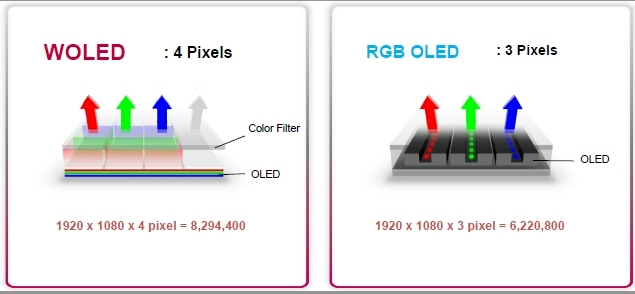elvn
Supreme [H]ardness
- Joined
- May 5, 2006
- Messages
- 5,312
On that actual prev topic, as I understand it LG OLED tvs use an all white array of OLEDs through a color filter layer which is LG's proprietary tech that got around the worst of the single colors fading first issue. It's sort of like a per pixel FALD, in the way that dual layer LCD is trying to do (but at 1080p on a 4k so far so not exactly 1:1 on those). Also obviously much slimmer and cooler running on OLED, plus viewing angles, response time etc but the comparison stands.

They also add a white pixel/clear filter in order to cheat the color brightness levels a little higher to your eyes without driving the OLED emitters brighter. So their color is not as accurate and loses some color saturation on the brightest tones as it's technically slightly white washed at higher levels. That as well as ABL on the HDR models it makes them impossible to calibrate properly. Still the C9's can display almost the entire DCI P3 color space (97.21%, 98.68%) and get 69% rec 2020 coverage.
https://www.rtings.com/tv/reviews/lg/c9-oled
I guess wear in makes sense in regard to persistent images. It sounds a lot more pleasant than "spot rotting" where you'd rather have the organics die slower and evenly like the rest of the screen over many years. A plant who loves shade having some of its leaves in direct sunlight too long go brown comes to mind. With HDR I'd compare display's constitution as if on different stove top burner settings.. simmer, medium, high. OLED has to keep on the low end or it will burn out it's glassware in spots .
.

LGD's WRGB architecture - which creates 4 sub pixels using color filters (reg, green, blue and non-filtered) to create a colored image from a single white OLED pixel - is less efficient and less color-pure compared to a real RGB sub-pixel architecture, but WOLED displays are much easier to produce as there's less need for subpixel patterning.
They also add a white pixel/clear filter in order to cheat the color brightness levels a little higher to your eyes without driving the OLED emitters brighter. So their color is not as accurate and loses some color saturation on the brightest tones as it's technically slightly white washed at higher levels. That as well as ABL on the HDR models it makes them impossible to calibrate properly. Still the C9's can display almost the entire DCI P3 color space (97.21%, 98.68%) and get 69% rec 2020 coverage.
https://www.rtings.com/tv/reviews/lg/c9-oled
The C9 can display a wide color gamut, which is great for watching HDR content. It can display almost the entire DCI P3 color space, which is great, and has good coverage of the wider Rec. 2020 color space.
I guess wear in makes sense in regard to persistent images. It sounds a lot more pleasant than "spot rotting" where you'd rather have the organics die slower and evenly like the rest of the screen over many years. A plant who loves shade having some of its leaves in direct sunlight too long go brown comes to mind. With HDR I'd compare display's constitution as if on different stove top burner settings.. simmer, medium, high. OLED has to keep on the low end or it will burn out it's glassware in spots
Last edited:
![[H]ard|Forum](/styles/hardforum/xenforo/logo_dark.png)